Roland Kenneth Paulson
Britt, Iowa
PROGRAMS:



COMPANIES:
LOCATIONS:
Patrick Air Force Base and Cape Canaveral, with several trips downrange to visit downrange tracking stations.
POSITIONS:
Instructor for Missile Tracking for the Air Force Eastern Test Range, Apollo Ships project manager
COMMENTS:
Getting the Space Program Off The Ground
The United States was in crisis mode when the country was caught flat-footed by the Soviet Union putting a satellite into orbit.
A crash program was launched to catch up, and my father was one of the people recruited to set up a program to get ahead of the Russians, and, in the words of President John F. Kennedy, “We choose to go to the Moon! We choose to go to the Moon in this decade and do the other things, not because they are easy, but because they are hard; because that goal will serve to organize and measure the best of our energies and skills, because that challenge is one that we are willing to accept, one we are unwilling to postpone, and one we intend to win.’’
The Soviet Union beat the United States by putting a satellite into orbit in 1957, and, in 1961, Russian cosmonaut Yuri Gagarin became the first man in space before the U.S. could launch its first Project Mercury astronaut.
My father, Roland K. Paulson, was one of those recruited for the project.
`
Roland Paulson, left, teaching a new class on missile tracking for the new space program
“The Missile Range technology was in its infancy in 1957. Staffing the operations management positions at Cape Canaveral and at down range stations and the ships was a problem because knowledgeable and experienced technical managers just did not exist on the labor or professional market,’’ he wrote.
My father was assigned in 1958 to create a training course to train engineers do something they had never done before. At the time, technology allowed tracking in two dimensions. Using LORAN, short for long-range navigation, was set up in World War II, and could track ships using two dimensions from separate locations, much like crossing an X on a map. The space program required at least three dimensions: height, distance and speed.
My father’s students included some of the best of the best, including engineers and military leaders. It was literally a crash course:
“The students were pushed to the limit to absorb all of the material (in 12 weeks), besides making a two-week training duty downrange. The pushing was essentially part of the training because the operations jobs demanded people who could operate under extreme pressure and could make accurate diagnoses of situations and follow it up with appropriate action in very short time intervals,’’ my father wrote in his diary.
As Dick Young of the Brevard Sentinel newspaper quoted my father in a story on March 14, 1962, “One of the biggest problems is keeping up with missiles and in the equipment that tracks them.’’
In those days, you didn’t run down to Radio Shack and buy the parts you needed to get a satellite and astronaut into orbit. They made them on the fly, and developed the equations needed to, in my father’s words, be able to track a baseball 1,000 miles away and determine if it was hit fair orHandwritten calculations for putting a satellite into space, from course instructions written by Roland K. Paulson.[/caption]
Lives depended on these calculations. If a missile veered off course, it was destroyed by explosives on board. My father trained pad safety officers who had to make quick decisions that could save lives. According to his course syllabus, “The up-range stations are equipped with powerful command transmitters which unquestionably have the ability to relay a destruct command to an errant vehicle.’’ We saw many missile explosions from our home in Cocoa, about 20 miles from the launch pad, as the early launch attempts failed in a rain of fire.
It was astronaut Alan B. Shepard Jr., the first man in space, who outlined a plan to land the man on the moon, according to documents collected by my father:
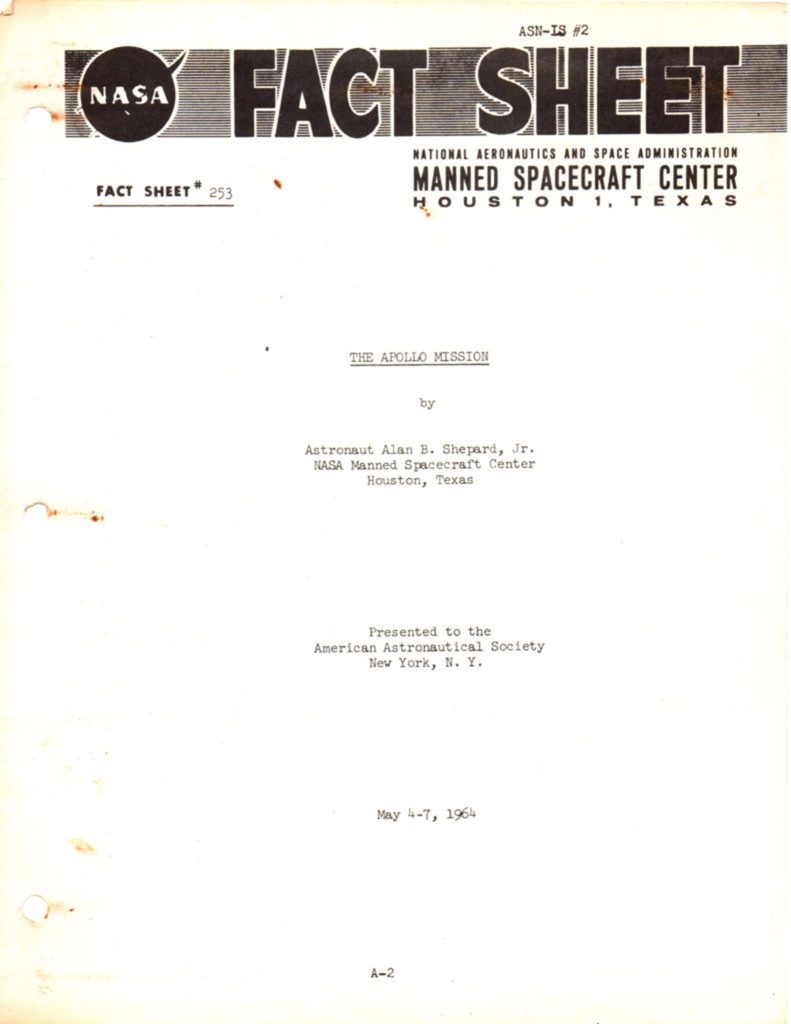
The proposal by Alan Shepard to put a man on the moon during a presentation in Houston in 1964
Fact sheet by Astronaut Alan Shepard on how to put a man on the moon, published in 1964. The plan is almost identical to the plan used by the United States to land on the moon in 1969.
They were exciting times. I noticed that my father “missed’’ the missile launches and failures we saw from our homes, and didn’t learn until many years later that he was just hundreds of yards from the launch pad, in a heavily fortified, concrete blockhouse where the space program was born.
Back then, the launches were secret, and my father followed the rules. However, there were other people on our block who were not so fastidious, and we developed a system where one of the space program workers would call home and tell one of his children to “go fix your bike,’’ which was a code that a launch was imminent and we would run up and down the block alerting neighbors, who ran down to the end of the street where we had a clear view across a swamp that allowed us to see the sky light up with fire, many times ending up in explosions during the early days. I later found out that the early launches were kept secret in part because of my father’s involvement. In those days, the pad safety officer sent a coded radio signal to destroy an errant missile, and the U.S. Air Force that ran the AFETR (Air Force Eastern Test Range) feared sabotage if someone got hold of the radio codes. As far as I know, it never happened.
A missile launch from Cape Canaveral as seen from Cocoa, Florida. Photo by Steven K. Paulson
When the secrecy lifted, after the successful launch of the Explorer satellite that propelled the United States into the space race, that families of the workers at Cape Canaveral were allowed onto the cape for a tour of the launch sites and we got to see the Mercury space capsule that would propel a U.S. astronaut into orbit.
We also got to see the computer center, which occupied an entire building. You have more computing power in your cell phone than the computers that put a man into space, but the computers they used were capable of solving 16 calculations simultaneously that could tell engineers almost exactly where the spacecraft was going and whether it would reach the intended orbit.
Here is a diagram on how the system worked:

Dick Young, the space writer for the Orlando Sentinel who became a NASA spokesman (We called him Ricky Rocket at the Sentinel) documented those early days in an article titled “Go, Baby, Go,’’ the buzzword among space geeks urging the missiles off their launch pads. Later, during manned launches, the new mantra was “Godspeed.’’
Young wrote about those early days, saying the Jupiter C that put the first U.S. satellite into space was a “souped-up Redstone, an early American rocket with direct ancestral ties to the German-built V-2.’’
He said the early version of the missile designed to put a satellite was a dismal failure, and had to be redesigned.
“The Eisenhower administration had assigned the task of orbiting the nation’s first satellite to the Vanguard, a pencil-thin rocket with development problems. Explorer 1 … was a mere toy in comparison to the size of the two Soviet satellites preceding it into space. Explorer I weighed a piddling 31 pounds,’’ he wrote.
There were so many failures in the early days of the space race, my father and the engineers had their own joke list:
“Vanguard, 72 feet of minor malfunctions!’’
“The Vanguard salute: hand clasped to forehead.’’
They also posted a sign on the blockhouse door following a Vanguard explosion on the pad: “Temporarily out of orbit.’’
One of the early attempts to develop rocket engines involved the Snark missile, which was really more like our cruise missiles. So many of them crashed into the sea that missile developers posted a sign near the beach at Cape Canaveral warning of “Snark infested waters.’’
There were other missiles that preceded the Snark. During the first decade of the space program, beginning in 1950, the first Lark missile was launched from the Cape. The first tracking station was built at Grand Bahama Island.
The first missile launched from Cape Canaveral was the two-stage “Bumper,’’ on July 24, 1950. It was a left-over German V-2 rocket from World War II.
In 1951, there was the first launch of the Matador from the Cape. By 1955, the U.S. added the Bomarc missile to its test program.
In 1956, the United States began the X-17 test program at the Cape to study re-entry problems by simulating re-entry velocities. That year, they also launched the Jupiter C, and a modified Redstone rocket carried an 84-pound payload more than 3,000 miles, but it wasn’t enough to put a satellite into orbit.
In 1957, the first attempt to launch the Thor rocket failed. They also tried to launch the first Atlas missile, which got off the pad but had to be destroyed.
On Jan. 31, 1958, Explorer 1 made it into orbit, dubbed “the Free World’s first Earth satellite.” Two months later, an attempt to put Explorer 2 into orbit failed.
Later that year, a Thor-Able rocket blew up 77 seconds after liftoff, but the U.S. program continued to race ahead, putting a live monkey into orbit on a Jupiter missile. The monkey died when a parachute malfunctioned.
In 1959, the United States successfully put two monkeys in space, named Able and Baker. The missile went 300 miles high, and the spacecraft and the monkeys were recovered alive.
The first test of the Mercury capsule came in 1959, when an Atlas missile carried “Big Joe I’’ flew 100 miles high and 1,500 miles downrange, a precursor to the first American in space, Alan Shepard.
Other missile designs followed. There was Mace, followed by the Titan rocket later used in the Gemini two-astronaut capsule, the Thor-Able-Star and the first Polaris nuclear missile launch from a submarine, the USS George Washington. There was the Minuteman, the Centaur and the Juno 2 that was used in 10 satellites launch attempts, six of which failed, including one rocket that cartwheeled off the launch pad.
Meanwhile, the Soviets weren’t letting up.
Howard Benedict, the famous Associated Press aerospace writer at Cape Canaveral in the early days, told me there was a Soviet spy ship off Cape Canaveral, waiting to spy on the first launch of a ballistic missile from a submarine.
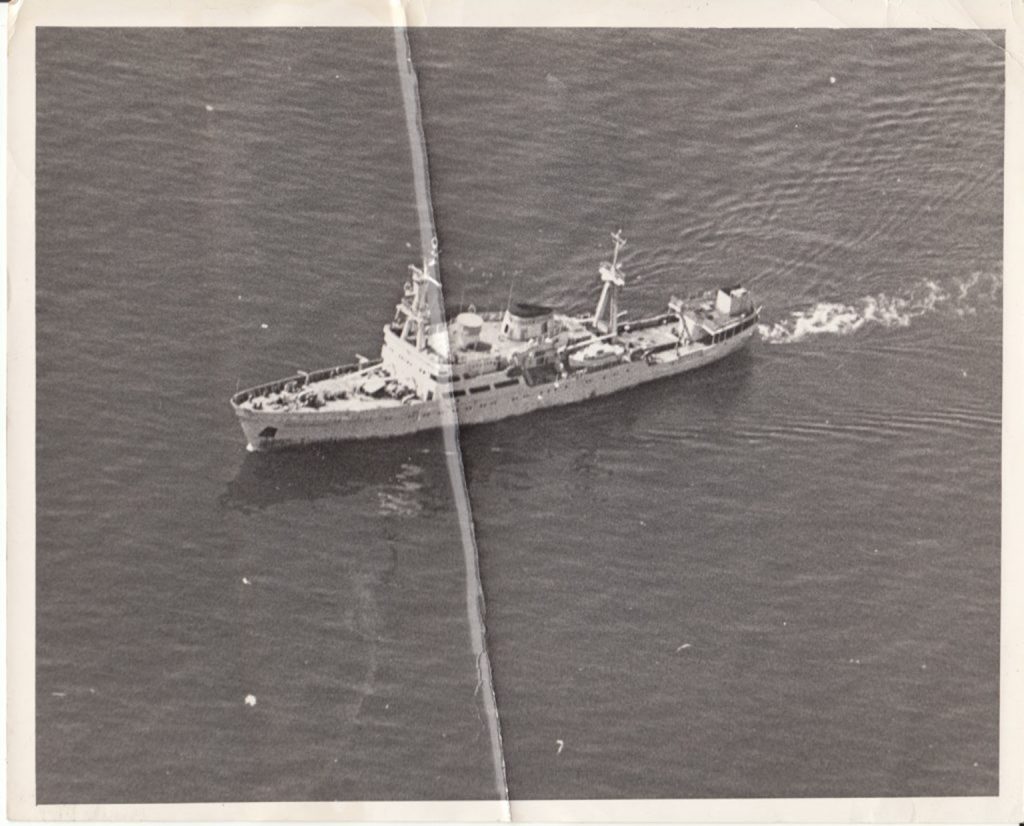
Photo of a Soviet Spy Ship off coast of Cape Canaveral awaiting submarine missile launch of one of the first multiple warhead nuclear missiles. Photo by Steven K. Paulson.
I rented a small plane with a pilot for this adventure on Merritt Island, a hop, skip and a jump from Cape Canaveral, and we flew east of the cape over the Atlantic Ocean, being careful to avoid the no-fly zone around the launch sites. After skimming waves for hours, we found the spy ship right where Benedict said we would find it, about 30 miles off the coast in international waters. A few fishermen on the boat were casting lines, but the array of antennas on board gave away its mission. We skimmed the top of the ship, taking pictures, while those on board glanced up at us and pretended to fish. At the time, the Pentagon was denying the AP story that a Soviet spy ship was interfering with the launch of the missile, so when my photos began moving on the wire, the Pentagon was quick to react. Reporters had been scheduled to go out on the USS Observation Island the next day to witness the launch and take photos, and those press passes were immediately rescinded. Members of the press began making their own arrangements for alternate transportation to photograph the launch, including renting shrimp boats and planes and the Pentagon was told reporters and photographers would be bouncing around their submarine and the Observation Island when they launched their missile. After all, if the Russians could watch, so could we. A few hours later the Pentagon restored our press passes.
A short time later, the United States navy launched the first Trident missile from a submarine.
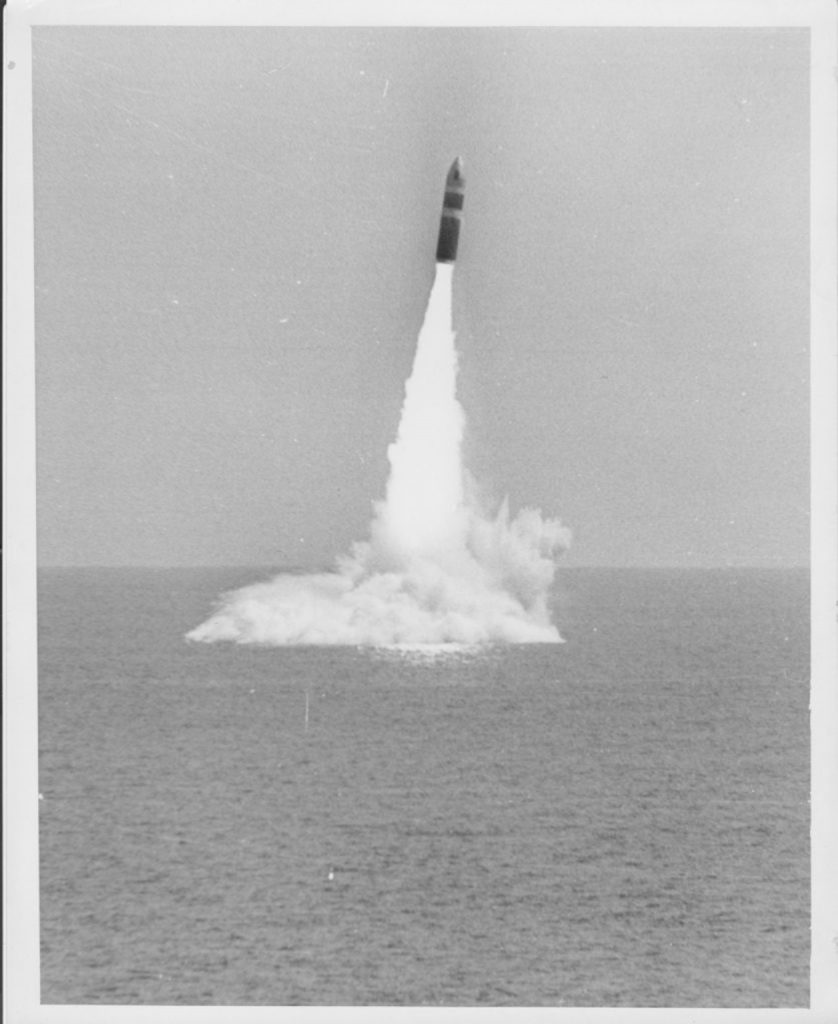
What followed could have brought the United States and the Soviets to war. When the missile was launched, the Soviets took their pictures and so did we. Then all hell broke loose. The Soviet ship shifted into high gear and scrambled to retrieve the nose cone covering the warheads to figure out how we had done it. The United States decided otherwise, and tried to ram the Soviet ship. The U.S. ship was only a few hundred yards behind as it steamed toward the rear of the Soviet ship, with no way to stop if either side blinked. The Soviet sailors made a futile grab for the bobbing nose cone coverings, but missed. The U.S. ships launched their own lifeboats with sailors carrying hooks to snag the missile covers. The Soviets sailed on. For some reason, it never made the history books, but it was one of the big confrontations of the Cold War.
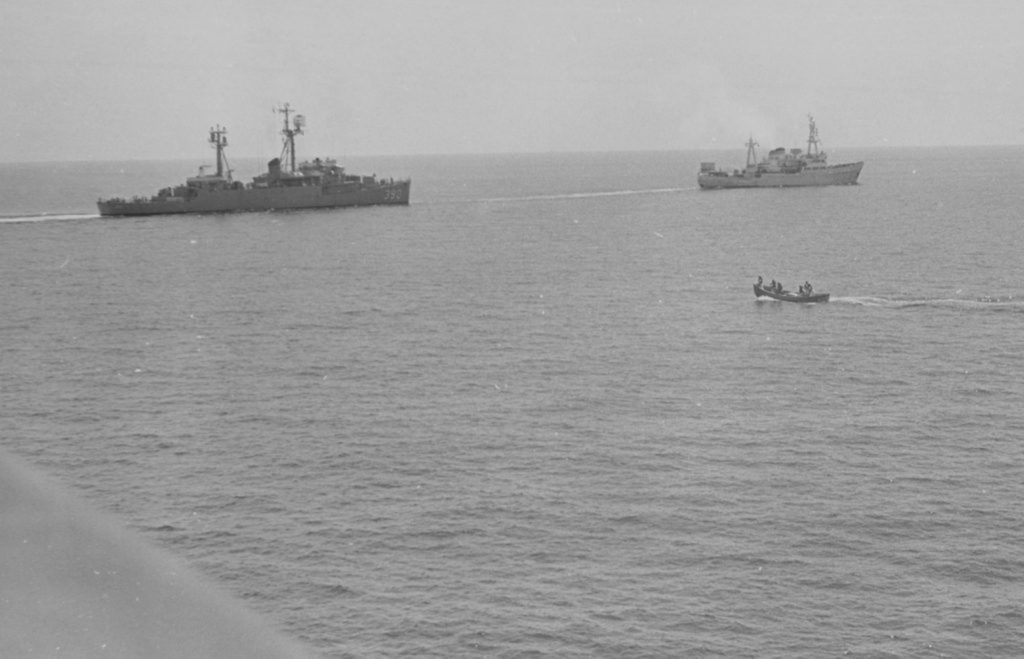
U.S. ship races to prevent Soviets from getting submarine missile parts. Photo by Steven Paulson
I didn’t know for years that my father worked in the space program, helping the U.S. Air Force set up the Air Force Eastern Test Range around the world, and later the Apollo ships program set up so NASA could stay in constant contact when our astronauts were on the moon. So the government was mighty angry when Benedict kept publishing stories that launches were imminent. It took them years to figure out Benedict wasn’t relying on sources. Benedict rented a room at a high-rise motel on Cocoa Beach and scanned the cape every day with a telescope. When he saw white clouds of liquid oxygen wafting over the cape, he knew they were fueling a missile and a launch could be imminent and he moved a story.
The space program also was dangerous, and the astronauts knew it. When the Apollo astronauts for Apollo 7, the first Apollo mission in space, died in a flash fire, my father heard the radio bulletin that the astronauts had died. It was one of the few times I saw him cry.
It was an incredible experience to watch the Apollo astronauts get into their van to take them to the launch pad, then listen to mission control and the countdown as it reached T-minus 9 seconds and the ground started rumbling as the engines roared to life.
Apollo astronauts head to the launch pad to board the Saturn V missile that would take them to the moon. Photo by Steven K. Paulson.
It was early morning when three men , Commander Neil Alden Armstrong, Command Module Pilot Michael Collins, and Lunar Module Pilot Edwin Eugene “Buzz” Aldrin, Jr. _ rode aloft on a giant Saturn V rocket to the moon on July 16. I have press passes from many major events I covered, from politics to the Olympics, but there were no press passes handed out for Apollo 11. They gave us a security badge, and they took it back when we left the cape. However, I’m most proud of my name, No. 207, on the long list of dignitaries and world figures who were there for the launch of Apollo 11.
I watched the lunar landing on July 20 at 20:17 UTC on television in the newsroom at the Sentinel with other reporters. Reporters are not supposed to show their emotions, but this time we all cheered. It was the only time I ever saw CBS news anchor Walter Cronkite speechless.
When the United States got serious and prepared to launch Alan Shepard into orbit, we were so close to Cape Canaveral, we would watch the liftoff on television at our elementary school, then run outside to see the rocket lift the astronauts into space. In those days, they didn’t have cameras they could attach to the missile to determine the cause of any malfunction, so they would launch jets from the west coast of Florida that screamed overhead so they could swing up close to the rocket and take camera shots for later review.
When the United States decided to make details of the space program public, NASA decided families of the men and women who worked there should be the first to tour the launch facilities and see the space craft. We walked around, marveling at the small size of the Mercury capsule, and the huge missiles that would eventually loft man into space. I got to cover almost all of the Apollo missions as an Orlando Sentinel photographer, and was sad to see the program end was interest in moon missions waned and attention turned to the Cold War. I would love to hear from some of his students.
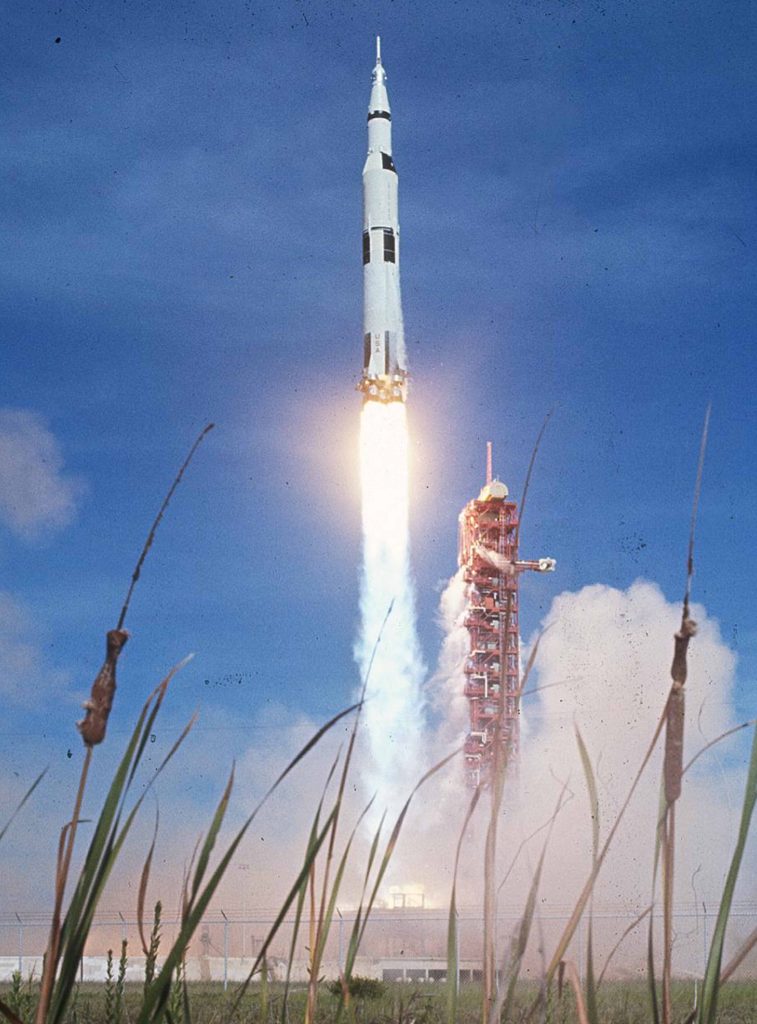
Apollo 15 Heads for the Moon in a photo taken by Steven K. Paulson with a remote camera.







